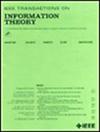The Existence of Distinguishable Bases in Three-Dimensional Subspaces of Qutrit-Qudit Systems Under One-Way Local Projective Measurements and Classical Communication
IF 2.2
3区 计算机科学
Q3 COMPUTER SCIENCE, INFORMATION SYSTEMS
引用次数: 0
Abstract
We show that every three-dimensional subspace of qutrit-qudit complex or real systems has a distinguishable basis under one-way local projective measurements and classical communication (LPCC). This solves a long-standing open problem proposed in [J. Phys. A, 40, 7937, 2007]. We further construct a three-dimensional space whose locally distinguishable basis is unique and apply the uniqueness property to the task of state transformation. We also construct a three-dimensional locally distinguishable multipartite space assisted with entanglement. On the other hand, we show that four-dimensional indistinguishable bipartite subspace under one-way LPCC exists. Our work offers profound insights and introduces a theoretical tool for understanding the local distinguishability of subspace. As a consequence, every qutrit channel has optimal environment-assisting classical capacity, and the environment-assisted classical capacity of every rank-three channel is at least单向局部投影测量和经典通信条件下qutrit-qudit系统三维子空间中可区分基的存在
我们证明,在单向局部投影测量和经典通信(LPCC)下,qutrit-qudit 复数或实数系统的每个三维子空间都有一个可区分的基础。这解决了[J. Phys. A, 40, 7937, 2007]中提出的一个长期悬而未决的问题。我们进一步构造了一个局部可区分基唯一的三维空间,并将唯一性应用于状态变换任务。我们还构建了一个辅助纠缠的三维局部可区分多方空间。另一方面,我们证明了在单向 LPCC 下存在四维不可区分的双方子空间。我们的研究为理解子空间的局部可区分性提供了深刻的见解和理论工具。因此,每个qutrit信道都有最优的环境辅助经典容量,每个秩三信道的环境辅助经典容量至少为$\log _{2} 3$ 。3$ .我们还证明,每一个双库特里特态都可以通过纠缠断裂信道转换成量子-经典边界附近的广义经典态。
本文章由计算机程序翻译,如有差异,请以英文原文为准。
求助全文
约1分钟内获得全文
求助全文
来源期刊

IEEE Transactions on Information Theory
工程技术-工程:电子与电气
CiteScore
5.70
自引率
20.00%
发文量
514
审稿时长
12 months
期刊介绍:
The IEEE Transactions on Information Theory is a journal that publishes theoretical and experimental papers concerned with the transmission, processing, and utilization of information. The boundaries of acceptable subject matter are intentionally not sharply delimited. Rather, it is hoped that as the focus of research activity changes, a flexible policy will permit this Transactions to follow suit. Current appropriate topics are best reflected by recent Tables of Contents; they are summarized in the titles of editorial areas that appear on the inside front cover.
 求助内容:
求助内容: 应助结果提醒方式:
应助结果提醒方式:


